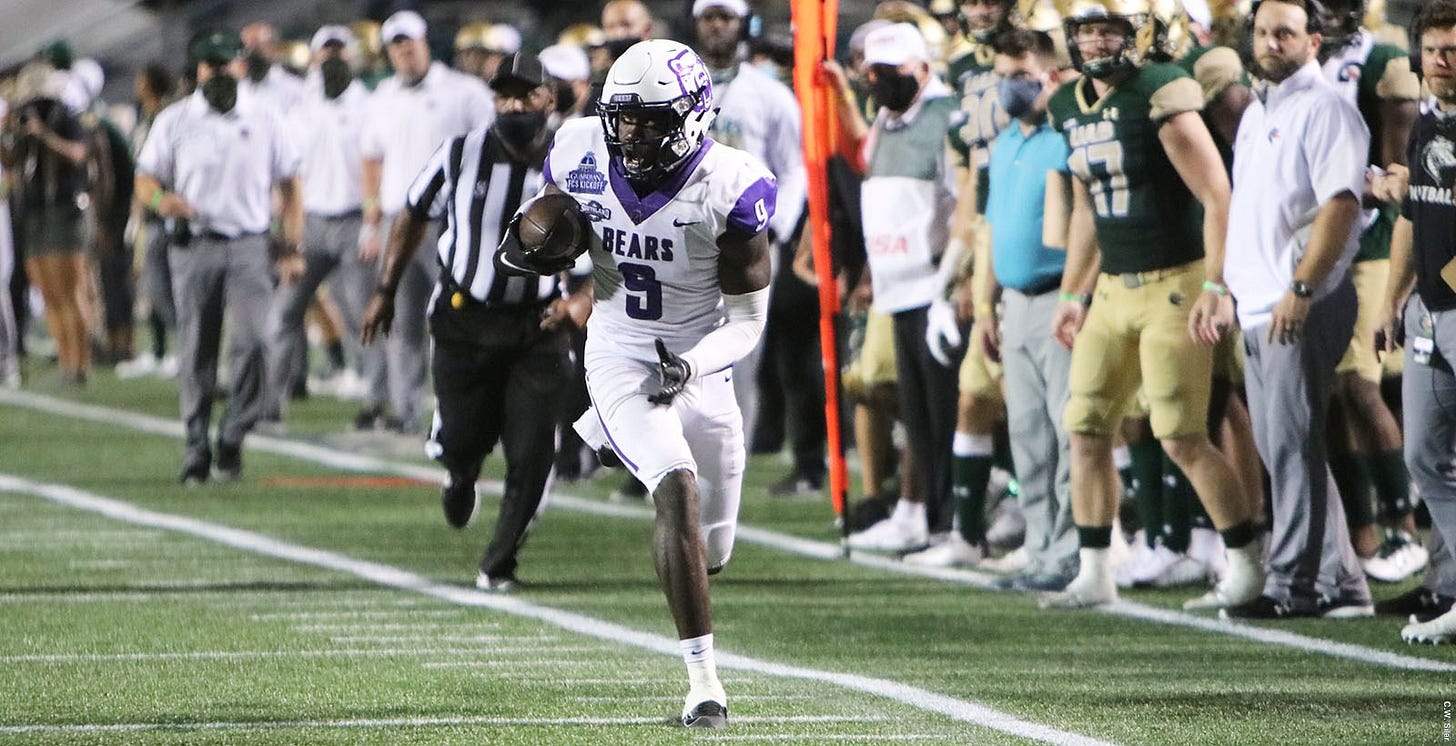The Designed Accident
How some college football teams are attempting to bubble, and why we can only hope it'll work.
Hello and thank you for reading!
This week’s Shutdown Fullcast is up, very loosely on the first two semi-weeks of the season, but mainly on British succession, a poop doctor in Arizona, and things of that nature. If this has convinced you to advertise on The World’s Only College Football Podcast, direct Serious Business inquiries to us at shutdownfullcast@gmail.com. We will fwd them to Serious Business people.
Elsewhere, support for Moon Crew’s free endeavors can be delivered in the amount of your choice at our Ko-fi page. Within a week or two, we’ll hopefully be set to share our first bonus for monthly donors: a community Moon Crew Discord.
What is a Designed Accident? A few examples:
Happening to have misplaced your wallet right at the moment when the bill arrives? That’s a Designed Accident.
When the would-be designated driver finds himself with a free drink in hand, then explains “it would be rude to say no,” we have a Designed Accident, a truly despicable one for everyone except the local ride share industry.
The flatscreen that suffers a Designed Accident has resulted in more new flatscreens for giddy dads than all intentional shopping ever has.
The Designed Accident is rebranded negligence, and it happens everywhere, all the time.
One more example! At the start of whatever the 2020 season will be, college football sits awkwardly in the middle of a Designed Accident.
It’s important to note some of this ain’t college football’s fault. Many schools — terrified of losing an entire semester of tuition and housing money — rushed students back to campus without much of a plan on what exactly to do once they arrived. Some, like Michigan State and UNC, have already canceled in-person instruction and gone remote, and others are doing so at least temporarily. As COVID-19 rates continue to spike on campuses, others will follow.
There is a possible Designed Accident outcome.
College football might end up being the happy fat kid eating free cake from this canceled wedding of a year.
This regrettable mayhem in higher education could end up leaving a few well-heeled football programs in a situation they might like: A semi-controlled environment where players attend class, but otherwise can be coerced to only come in contact with those inside the program.
After all, the Designed Accident Bubble looks like everything a coach could want: Partial isolation from the anarchy of the regular student body, and without the players in a setup given the suspiciously professional title of “bubble.” Ahem, the student-athletes.
Yet after talking on background to some coaches and administrators at major programs in three conferences, the important word seems to be “could.”
There is at least one data point suggesting the Designed Accident Bubble could work. Yet even with the best versions of that Designed Accident Bubble, there are built-in, insurmountable problems unique to college sports.

Central Arkansas has already managed to play twice, with zero positive tests after at least the first game. Photo: MacKenzie Magwire, Central Arkansas.
Even with remote classes, players are still 18 to 22 years old and living in college towns.
A lot of players have already been on campus for most of the summer, engaged in workouts and fall practice. By all accounts given to me, they wash hands, limit contact, and exceed basic protocols.
It’s everyone else in town that presents the real issues. Even if teams manage to do everything they are supposed to, they still have to live and eat and sleep in or near the rest of the school.
Schools and their surrounding communities are filled with people keeping bad hours, drinking, socializing in close quarters, and many other things likely to spread the virus. This will still be true even with some schools leaving campus half-empty, and others not telling students where to go at all.
College in general constitutes a four-year challenge to the immune system, health care wisdom, and common sense. So in a pandemic, college all but guarantees a rapid spread of the virus.
It is, at the moment and for lack of a better word, bad. All very, very bad. Using the best numbers available, many school populations are experiencing grievous levels of COVID transmission. Using the best quick survey of TikTok and Twitter I could conduct, many student bodies are also experiencing worrying levels of not worrying about COVID — or anything else, for that matter — at all.
Programs ultimately do not have much control of players, especially in the year 2020.
Coaches and admins expressed a serious sense of resignation about how much they can actually make players do.
The NCAA’s provision allowing players to opt out of 2020 penalty-free gave players some additional sway, a decision perhaps encouraged by increasingly vocal players. Coaches and administrators worry about what future flexes of player agency might look like.
But there is something more fundamental, extending beyond the moment. One shortcoming of college football not paying its players is college football being unable to come to terms with player demands. It’s not just that college players can’t bargain with institutions. Institutions can’t bargain back.
Playing time, the vague promises of postgraduate connections, and networking can only go so far in guaranteeing a player will do anything, much less adopt the kind of 24/7 vigilance required during an outbreak.
Oh, and for every FBS program, there will be around 105 players doing this dance, every day for every week of the abbreviated season. All of these players, in the last three months, have witnessed or partaken in the biggest display of player power in the history of college athletics. All of them have the right to opt out without penalty. A good number would like to hang out at least once this fall with someone not on the team. GOOD LUCK.
There is no standard college town to plan for, or against.
University towns come in shapes big and small, with wildly varying results in containing COVID-19. A school like Miami, in the middle of a large city, might somehow have only 103 active cases in a week. Washington State in isolated Pullman, meanwhile, has had a sharp enough spike to merit the National Guard’s assistance with testing.
Even worse, it’s not like the student bodies of football schools can be counted on to have a uniform response. There is some hope in a place like Pullman, in a state where quick response by the governor and local governments curbed one of the first big COVID outbreaks in the United States. For a place like Auburn, where the state government took months to gently suggest mask-wearing, and the students are what I would kindly call “skeptical” of COVID’s risks, the prospects of snuffing an outbreak seem dim.
TL;DR: Even if you get the football protocols right, there’s no guarantee your work won’t be undone by the city council, the governor, or a local 19-year-old who thinks masks are for commies.
There are so many university things that football people can’t control.
In another quirk of amateurism, football programs have surprisingly little control over their own affairs. The brouhaha surrounding the Big Ten’s cancelation is a perfect example. The people yelling at commissioner Kevin Warren can holler until they’re hoarse, and that alone can’t change the decision by the universities — by their presidents, provosts, and donors — not to play this fall.
And though this might come as a shock to a football person, there’s one more brake: Universities tend to have a love/hate relationship with college football.
They love some things, like when victories drive up application numbers and generate revenue to build facilities or support other athletic programs.
They hate some things, like paying huge buyouts to coaches, the vocal influence of boosters who barely contribute to anything else at the school, complaints by academic staff about athletics being a distraction from the university’s mission, the periodic havoc wreaked on campuses by tailgating fans, and when scandal threatens to get the entire administration canned. And the minute liability rears its head in any substantial way, all bets fly out the window.
To paraphrase one coach I spoke with, the two things that get presidents fired are docs and jocks. A potential scandal involving one is often enough to end a regime, but combining both is emptying a dump truck of warning bells on the desk of a school president.
If college football teams try to exploit the Designed Accident Bubble into a full season? That’s still a bubble that could get popped at any time by their overlords.




College AD's, coaches, and football players greatly over estimate how important football is to students, other than it being an excuse to get drunk and party. The "if you want to have football, avoid the bars" tweets don't really do much.